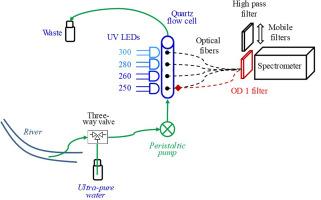New automatic fluorescence monitoring system for insecticides in surface and groundwater. Applications to pyrethroids in the Niayes agricultural area of Senegal
IF 4.6
2区 化学
Q1 SPECTROSCOPY
Spectrochimica Acta Part A: Molecular and Biomolecular Spectroscopy
Pub Date : 2025-09-12
DOI:10.1016/j.saa.2025.126916
引用次数: 0
Abstract
In this paper, we present the design of a new automatic fluorescence monitoring system (AUTOFLUO) for real-time control of pesticide contamination in natural waters. This system was used to analyse two fluorescent pyrethroid insecticides, phenothrin (PHE) and permethrin (PER), currently used in the Niayes agricultural district in Senegal. The results were then compared with those obtained using the classical fluorescence method (FLUO). The analytical parameters (λex, λem, and pH) were optimised. Phenothrin exhibits maximum excitation and emission wavelengths of 221 and 321 nm, respectively, whereas permethrin has these values at 210 and 297 nm. The optimum pH value was determined to be 7 for PHE and 8 for PER. The linearity of both the calibration and standard addition curves was validated through variance analysis. A Student's t-test demonstrated that the intercept values of the calibration curves were not significantly different from zero (p > 5 %). The limit of detection (LOD) ranges from 0.02 to 5.16 ng mL−1, while the limit of quantification ranges from 0.07 to 17.18 ng mL−1. Comparing these LOD values with those reported in the literature demonstrates the high sensitivity of the AUTOFLUO method. Both insecticides were analysed in spiked natural waters using the standard addition procedure. Satisfactory recovery rates were obtained by the FLUO (88.9 % to 97.6 %) and the AUTOFLUO (95.7 % to 102.8 %) methods. The low intraday and interday relative standard deviations (< 2 % and < 4 % respectively) attest to the repeatability and reproducibility of the measurements. The satisfactory tolerance limits of the interfering species validate the method's selectivity. These results demonstrate that the AUTOFLUO system is suitable for reliably monitoring pesticides in natural waters.

新型地表水和地下水中杀虫剂自动荧光监测系统。拟除虫菊酯在塞内加尔尼亚耶斯农业区的应用。
本文设计了一种新型的自动荧光监测系统(AUTOFLUO),用于实时监测天然水体中农药的污染。该系统用于分析目前在塞内加尔Niayes农业区使用的两种荧光拟除虫菊酯杀虫剂,即苯氰菊酯(PHE)和氯菊酯(PER)。然后将结果与经典荧光法(FLUO)得到的结果进行比较。对分析参数(λex、λem、pH)进行优化。苯氰菊酯的最大激发和发射波长分别为221和321 nm,而氯菊酯的最大激发和发射波长分别为210和297 nm。PHE的最佳pH为7,PER的最佳pH为8。通过方差分析验证了标定曲线和标准添加曲线的线性关系。学生t检验表明,校准曲线的截距值与零无显著差异(p < 0.05)。检出限为0.02 ~ 5.16 ng mL-1,定量限为0.07 ~ 17.18 ng mL-1。将这些LOD值与文献报道的LOD值进行比较,证明了AUTOFLUO方法的高灵敏度。使用标准添加程序在加药后的天然水中对两种杀虫剂进行了分析。FLUO法和AUTOFLUO法的回收率分别为88.9% ~ 97.6%和95.7% ~ 102.8%。日内和日内相对标准偏差较低(< 2%和
本文章由计算机程序翻译,如有差异,请以英文原文为准。
求助全文
约1分钟内获得全文
求助全文
来源期刊
CiteScore
8.40
自引率
11.40%
发文量
1364
审稿时长
40 days
期刊介绍:
Spectrochimica Acta, Part A: Molecular and Biomolecular Spectroscopy (SAA) is an interdisciplinary journal which spans from basic to applied aspects of optical spectroscopy in chemistry, medicine, biology, and materials science.
The journal publishes original scientific papers that feature high-quality spectroscopic data and analysis. From the broad range of optical spectroscopies, the emphasis is on electronic, vibrational or rotational spectra of molecules, rather than on spectroscopy based on magnetic moments.
Criteria for publication in SAA are novelty, uniqueness, and outstanding quality. Routine applications of spectroscopic techniques and computational methods are not appropriate.
Topics of particular interest of Spectrochimica Acta Part A include, but are not limited to:
Spectroscopy and dynamics of bioanalytical, biomedical, environmental, and atmospheric sciences,
Novel experimental techniques or instrumentation for molecular spectroscopy,
Novel theoretical and computational methods,
Novel applications in photochemistry and photobiology,
Novel interpretational approaches as well as advances in data analysis based on electronic or vibrational spectroscopy.

 求助内容:
求助内容: 应助结果提醒方式:
应助结果提醒方式:


